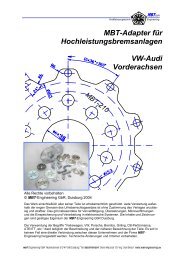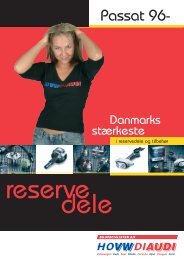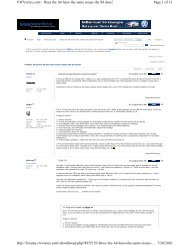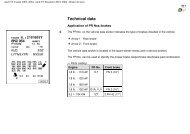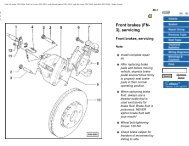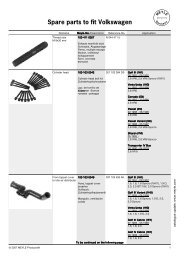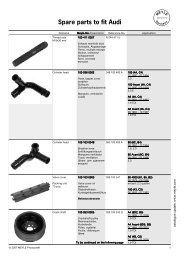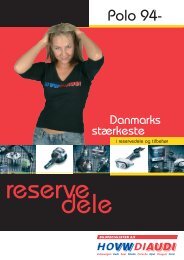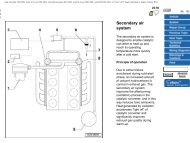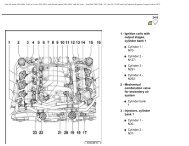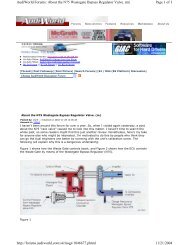VW MKII A2 MK2 Golf Jetta Fox Service Manual - VAGLinks.com
VW MKII A2 MK2 Golf Jetta Fox Service Manual - VAGLinks.com
VW MKII A2 MK2 Golf Jetta Fox Service Manual - VAGLinks.com
Create successful ePaper yourself
Turn your PDF publications into a flip-book with our unique Google optimized e-Paper software.
21 Crankshaft and bearings -<br />
examination and renovation 5<br />
1 Examine the bearing surfaces of the<br />
crankshaft for scratches or scoring. Using a<br />
micrometer, check each journal and crankpin<br />
for ovality. Where this is found to be in excess<br />
of 0.17 mm, the crankshaft will have to be<br />
reground and undersize bearings fitted.<br />
2 Crankshaft regrinding should be carried out<br />
by a specialist who will normally supply the<br />
matching undersize main and big-end shell<br />
bearings.<br />
3 If crankshaft endfloat is more than the<br />
maximum specified amount, new centre main<br />
bearing shells with side flanges will have to be<br />
fitted to replace the thrustwashers. These are<br />
usually supplied together with the main and<br />
big-end bearings on a reground crankshaft.<br />
22 Cylinder block/crankcase -<br />
examination and renovation 5<br />
1 The cylinder bores must be examined for<br />
taper, ovality, scoring and scratches. Start by<br />
examining the top of the bores. If these are<br />
worn, a slight ridge will be found which marks<br />
the top of the piston ring travel. If the wear is<br />
excessive, the engine will have had a high oil<br />
consumption rate ac<strong>com</strong>panied by blue<br />
smoke from the exhaust.<br />
2 If available, use an inside dial gauge to<br />
measure the bore diameter just below the<br />
ridge and <strong>com</strong>pare it with the diameter at the<br />
bottom of the bore, which is not subject to<br />
wear. If the difference is more than 0.15 mm,<br />
the cylinders will normally require reboring<br />
with new oversize pistons fitted.<br />
3 If cylinder bore wear does not exceed 0.20<br />
mm, special oil control rings and pistons can<br />
be fitted to restore <strong>com</strong>pression and stop the<br />
engine burning oil.<br />
4 If new pistons are being fitted to old bores,<br />
it is essential to roughen the bore walls<br />
slightly with fine glasspaper to enable the new<br />
piston rings to bed in properly.<br />
5 Thoroughly examine the crankcase and<br />
Engine repair procedures - 1.05 and 1.3 litre pre August 1985 2A•13<br />
22.6 Core plugs in cylinder block<br />
cylinder block for cracks and damage and use<br />
a piece of wire to probe all oilways and<br />
waterways to ensure that they are<br />
unobstructed.<br />
6 Check the core plugs for leaks and security<br />
(see illustration).<br />
23 Pistons and connecting rods<br />
- examination and renovation 4<br />
1 Examine the pistons for ovality, scoring and<br />
scratches. Check the connecting rods for<br />
wear and damage.<br />
2 To remove the pistons from the connecting<br />
rods, first mark the two <strong>com</strong>ponents in<br />
relation to each other. The indentation on the<br />
bearing end of the connecting rod faces the<br />
same way as the arrow on the piston crown<br />
(see illustration).<br />
3 Prise out the circlips then dip the piston in<br />
hot water. Press out the gudgeon pin and<br />
separate the piston from the connecting rod.<br />
4 Assemble the pistons in reverse order.<br />
5 If new rings are to be fitted to the original<br />
pistons, expand the old rings over the top of<br />
the pistons by using three old feeler blades to<br />
prevent the rings dropping into empty<br />
grooves.<br />
6 Before fitting the new rings, insert each of<br />
them into the cylinder bore approximately<br />
15.0 mm from the bottom and check that the<br />
end gaps are as specified (see illustration).<br />
7 When fitting the rings to the pistons, ensure<br />
that the TOP markings face towards the<br />
23.2 Indentations on big-end bearings<br />
(arrowed) must face same way as arrow on<br />
piston crown<br />
piston crown and arrange the end gaps at<br />
120° intervals (see illustration). Using a feeler<br />
blade, check that the clearance of each ring in<br />
its groove is within the limits specified (see<br />
illustration).<br />
24 Oil pump - examination and<br />
renovation 3<br />
Note: The manufacturer does not supply any<br />
clearances for checking oil pump gear wear,<br />
so the pump must be assumed to be in good<br />
order provided that oil pressure is as<br />
specified. Pressure can only be checked with<br />
the engine assembled and the task should be<br />
entrusted to a <strong>VW</strong> garage. A visual<br />
examination of the oil pump can be made as<br />
follows:<br />
1 Using an Allen key, unscrew the relief valve<br />
plug and extract the spring and plunger (see<br />
illustrations).<br />
2 Using an impact screwdriver, remove the<br />
cross-head screws and withdraw the cover<br />
from the pump (see illustration).<br />
3 Remove the rotors, noting that the<br />
indentation on the outer rotor faces the cover<br />
(see illustrations).<br />
23.6 Checking piston ring gaps 23.7a Space ring gaps at 120° intervals 23.7b Checking piston ring-to-groove wall<br />
clearance<br />
1081 <strong>VW</strong> <strong>Golf</strong> & Jeta<br />
2A



